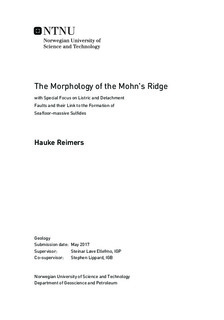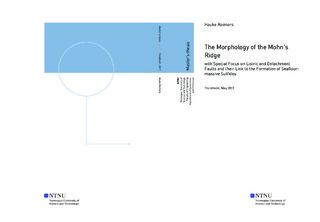| dc.description.abstract | Slow and ultraslow-spreading mid-ocean ridges are linked to limited magma supply, discontinuous axial volcanic ridges, asymmetric flank development and formation of oceanic core complexes where lower crustal and upper mantle lithologies are frequently exposed. It is estimated that more than 80 % of the yet to be discovered seafloor-massive sulfide deposits will be found on slow and ultraslow-spreading ridges. The Mohn s Ridge is an ultraslow-spreading ridge segment of the Arctic mid-ocean ridge, where several active and inactive hydrothermal fields and deposits have been discovered, among them the active black smoker vent field Loki s Castle . The ridge lies within Norwegian Jurisdiction and in light of potential future mineral exploration, warrants further investigation of its morphology, geological structures and their connection to the formation of hydrothermal mineral deposits.
By using digital terrain analysis of a gridded bathymetry, seismic reflection profiles and teleseismic earthquake data, the investigation shows that the northern Mohn s Ridge displays a pronounced asymmetric flank development. The western flank hosts several structures that have been identified as oceanic core complexes, characterized by ridge-parallel, outward-facing breakaway ridges and dome-shaped central surfaces, often displaying ridge-perpendicular corrugations or rafted blocks. Major normal faults close to the valley walls frequently show significant amounts of outward-rotation. In comparison, the eastern flank does not show the same amount of topographical relief and is characterized by the presence of volcanic abyssal hills, which show little to no rotation. From north to south, the ridge transitions from a distinctly asymmetrical to a more symmetrical flank topography, implying that the magma availability increases accordingly. Normal faults at the ridge likely show listric geometries at depth, however, their exact behavior is uncertain due to a lack of subsurface information. The core complexes and their associated detachment faults are probably not active any longer, as they have all been cut off from the axial valley by newer, rotated normal faults.
Major, rotated normal faults located close to the axial valley walls and axial volcanic ridges indicate a significant potential for channeling fluids and building ore deposits, and should therefore be taken into consideration in future exploration. Non-transform faults effectively segment the ridge between the axial volcanic ridges and are indicated to be significant contributors to hydrothermal circulation. However, it should be investigated in further studies what role they may play as potential prospecting tools. | |

